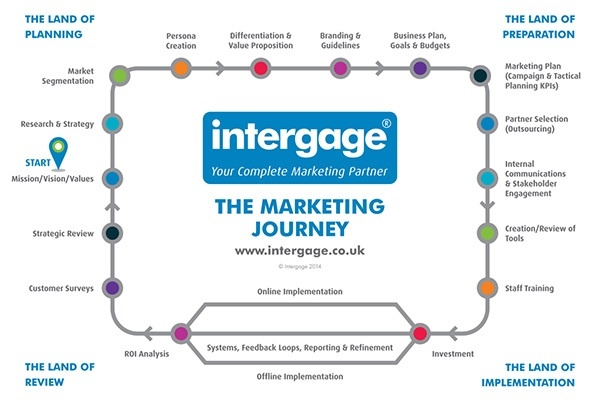What is Marketing Automation?
Marketing Automation encompasses software, content and a strategic process. Its purpose is to help you guide potential customers along their buying journey - 24/7/365 - with little or no human input.
It exists to help you attract and nurture prospects until they become ready to buy (or engage with your sales team).
The aim is to turn strangers into warm prospects...warm prospects into customers...and customers into evangelists. You do this by using high-quality content which is:
- relevant
- useful
- personalised
- high-quality
- timely.
Key Features of a Marketing Automation System
There are several Marketing Automation systems on the market. But typically, they offer this range of features.
- Lead Scoring – applying scores to customer contacts based on their behaviour
- Lead Nurturing – triggering automated content to nurture customers until ready to buy
- Email Marketing – Managing day to day marketing communications and driving leads to…
- Landing Pages – Creating personalised content that converts website visitors from strangers to visitors or form leads to qualified leads
- Campaign Management – manage multiple campaigns simultaneously
- CRM Integration – pass leads directly into the CRM system (some come with a free CRM)
- Social Media Integration – Marketing automation is multi-channel – its not all about email.
What Marketing Automation Isn’t
It might help to frame this if we also looked at what it isn’t:
Just Software – Some online definitions suggest that Marketing Automation is software.
I think that is misleading.
Ultimately, you will need a software platform to implement Marketing Automation. But before you start configuring software (or, heaven forbid, paying a software license fee) you need to have done all your preparation.
You need to have ‘nailed’ (or at least visited) the first few stops on the Marketing Journey. Do you have a clear mission and values, have you segmented your audience and built detailed personas around them?

More important than the software is the discipline that it will bring to transform your marketing processes and to really look after your customers and prospects.
Glorified Email Marketing – Having explained what marketing automation is to dozens of customers, occasionally I get the response “Oh, so it’s sort of email marketing with knobs on?”
No. No it isn’t.
There are email marketing systems that can do some aspects of automation like moving contacts into dynamic lists, depending on their behaviour. But that is not the whole story.
May I refer you (m’ learned friends) to the features listed above? We can combine email marketing and lead nurturing with lead scoring, f to identify exactly when a customer is ready to buy based on their behaviour. And then tell the sales team.
You can’t do that with email marketing systems.
Dead Easy – We have been through the process of getting ready for Marketing Automation. As a marketing agency, we thought we had a pretty good idea of who we sold to, and who our marketing personas were for our mainly B2B audience.
What we found surprised us. When we revisited our personas, we realised that there weren’t four of them, but seven and that we needed to build a much more complete picture of them. We even found photographs of each one to really bring home to us who our audience is.
What are the Limitations of Marketing Automation?
Very often Marketing Automation works best (and is applied to) one section of your sales funnel. Normally the part that turns cold leads into warm (Marketing Qualified) leads. It is particularly good for this as its lead nurturing capabilities mean that it can automatically ‘look after’ the customer relationship.
It can be configured to respond to customers with relevant personalised messages, based on their behaviour, until they are ready to move to the next level of engagement.
At that point, through lead scoring, Marketing Automation can then highlight the lead as a Marketing Qualified lead, and pass it to Sales. Perfect!
But what about the rest of the funnel?
As part of a fully rounded Inbound Marketing Strategy, Marketing Automation is a crucial component. But if you are only using Marketing Automation you may just be ‘supercharging’ one section of your sales funnel.
For your marketing to take off, you also need to be working on attracting strangers to your website, and converting them into leads. Then you can let Marketing automation convert them into marketing qualified leads through lead nurturing.
The way to do that is with a content strategy that optimises the chances of that content being found for a range of Google searches. That range of searches should be on problems that your target audience is experiencing that your product or service can help with.
The other limitation of Marketing Automation is that it is only as good as the process (or processes) that you build. We could look at plenty of B2B marketing processes, and the last thing that we should do is automate them!
First of all, you’ll need to transform your marketing processes. Which most often begins with deeply understanding your audience. That means thinking hard about the personas that you sell to and building complete back-stories for them.
If you don’t deeply understand your audience and what makes them tick, how will you be able to write great content for them in their language that they respond to?
So, the processes that you build, and how well you do that, will be a limiting factor to your marketing automation success.
So, make sure that you are working with someone who has done this before and can guide you.
How do you know if it is right for you?
Newsflash – “Marketing Automation may not be the answer for every organisation!”
If you are not producing a steady stream of leads, maybe the first place to start is with an inbound strategy that produces more leads. Then you can bring marketing automation in to nurture those leads until they are ready.
Big businesses have been using Marketing Automation for a long time now, but the fastest growing sector is the SME (Small to Medium sized Enterprise) sector.
Even really small organisations can use Marketing Automation. We work with a marketing automation guru who has just two people in his organisation, because Marketing Automation is delivering a lot of the work of looking after customers for him.





